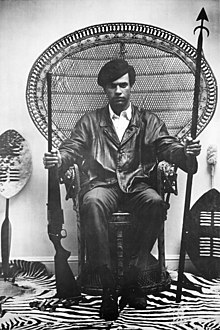Peacock chair

The peacock chair is a chair made of woven rattan or bamboo with a flared back, originated in the Philippines.[1] It became popular in the United States and abroad during the 20th century, as a thronelike symbol of status, being featured in photographies with politicians, revolutionary leaders, actors and musicians.[2]
History
[edit]The peacock chair is one of several wicker chair designs to have originated from The Philippines and popularized in the US after the 1876's Philadelphia Centennial Exhibition.[3]
This design originated in The Philippines, as a chair produced by inmates of the Bilibid prison in the early 20th-century. During the American colonial period, the prison was espoused by colonizers as a 'benevolent' institution, where prisoners in rehabilitation programs made articles like furniture, silverware and baskets.[4] The products were exposed at the prison workshop and sold to tourists.
One of the first peacock chair photos to popularize the model was featured in the May 16–17, 1914 edition of the El Paso Herald, with a female inmate from the Philippine with her baby was sat on it.[5]
Design
[edit]The chair has an hourglass shaped base, lifted arms and a woven flared back resembling a peacock's tail.[6]
Symbol
[edit]With the popularization of photography, photographers employed wicker chairs as a prop seat for its sturdy, lightweight appearance. The peacock chair acquired a status symbol, with its thronelike appearance, favored for shoots with politicians, artists and celebrities.[2] The 1967 Blair Stapp photograph of Huey P. Newton, founder of the Black Panther Party, sitting on the chair with a spear and a rifle in each hand, became especially notable as a Black power movement icon.[7][8]
The peacock chair was also featured on the screen, like Morticia Addams' chair in the 1964 television series The Addams Family.[3] The chair also appeared in film, like My Fair Lady (1964), Emmanuelle (1972) and Black Panther (2018).[9]
The peacock chair was a trend in album covers, such as Al Green's I'm Still in Love With You (1972), Dorothy Moore's Misty Blue (1976), Al di Meola's Casino (1978), Funkadelic's Uncle Jam Wants You (1979) and Heaven 17's Play to Win (1981).[10]
References
[edit]- ^ https://www.esquiremag.ph/long-reads/features/rattan-peacock-chair-bilibid-a00293-20200624-lfrm
- ^ a b "Only the coolest people get to sit in the wicker peacock chair". DangerousMinds. 2015-11-04. Retrieved 2024-05-14.
- ^ a b "The Comeback of the Peacock Chair, Morticia Addams's Favorite Seat - WSJ". 2016-08-25. Archived from the original on 2016-08-25. Retrieved 2024-05-14.
- ^ Mallari, Aaron Abel T. (2012). "The Bilibid Prison as an American Colonial Project in the Philippines". Philippine Sociological Review. 60: 165–192. ISSN 0031-7810. JSTOR 43486344.
- ^ "Jail Bird in a Peacock Chair". El Paso Herald. May 16–17, 1914. p. 22.
- ^ "This is Poised to be the Statement Seat of the Summer". 14 October 2019.
- ^ "The History Behind the Iconic Peacock Chair". ArtRKL. 2023-07-12. Retrieved 2024-05-14.
- ^ Avery, J. Nailah (2023-02-24). "How the Peacock Chair Became a Symbol of Black Power and Liberation". Architectural Digest. Retrieved 2024-05-14.
- ^ "Why the Peacock Chair matters | design | Agenda | Phaidon". www.phaidon.com. Retrieved 2024-05-14.
- ^ Caswell, Estelle (2019-10-04). "How this chair became a pop culture icon". Vox. Retrieved 2024-05-14.
